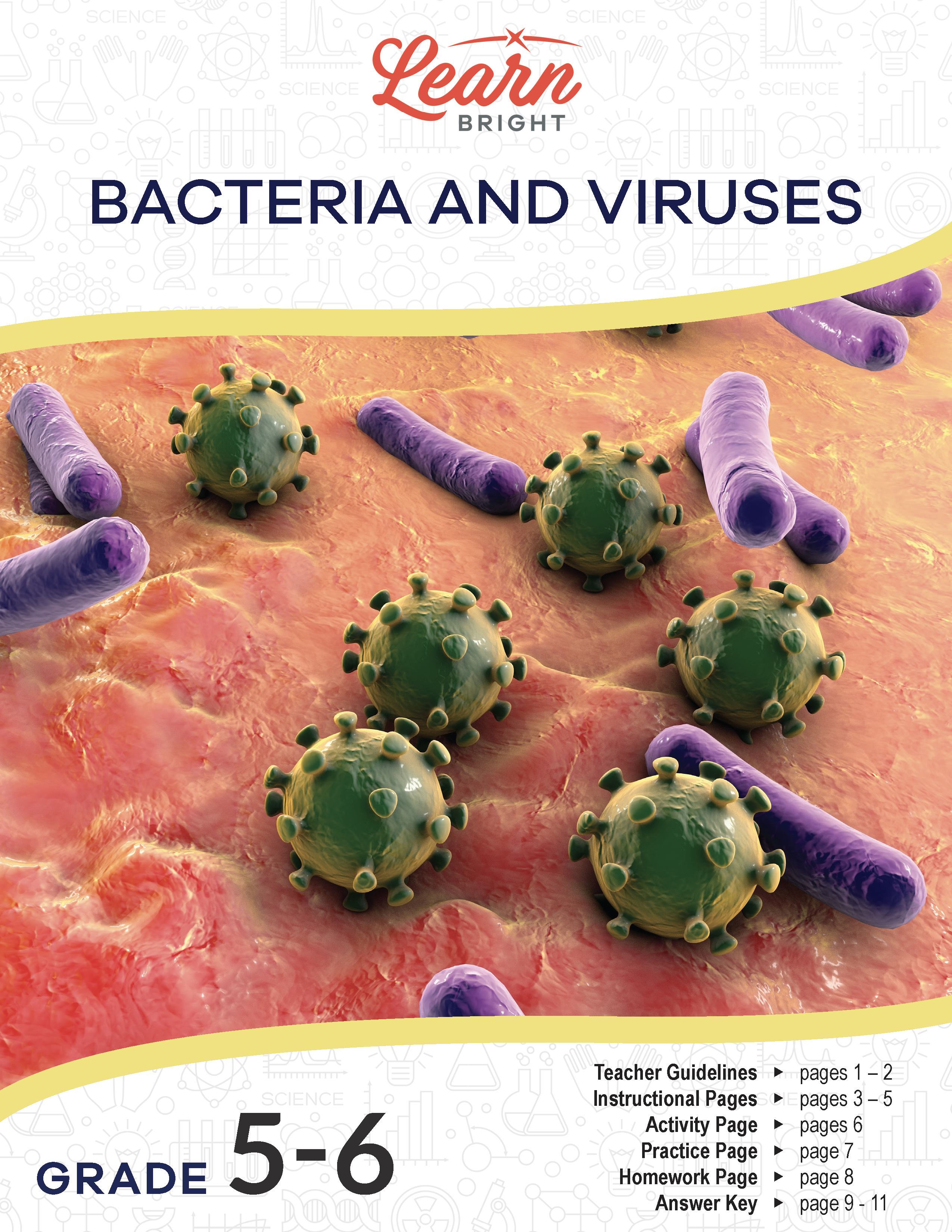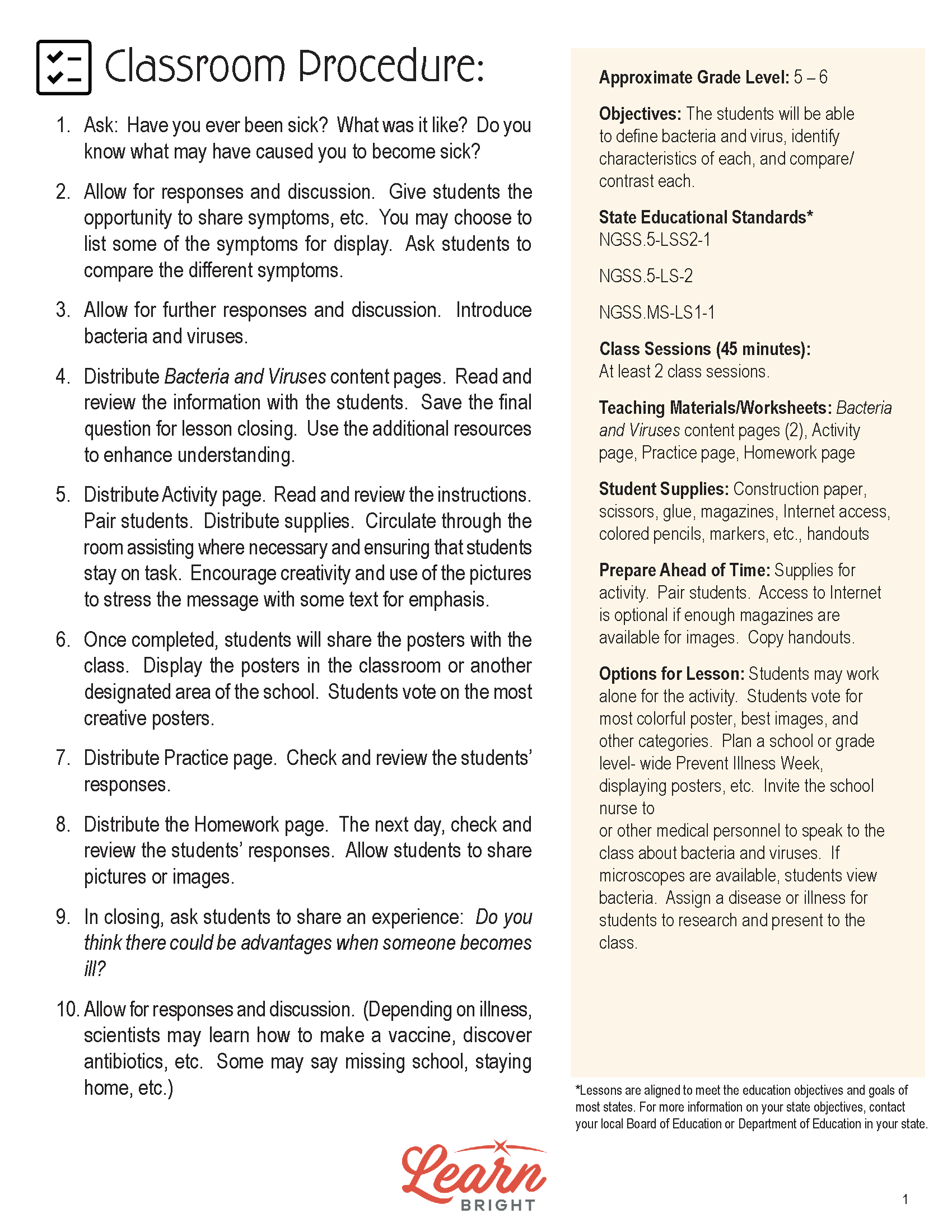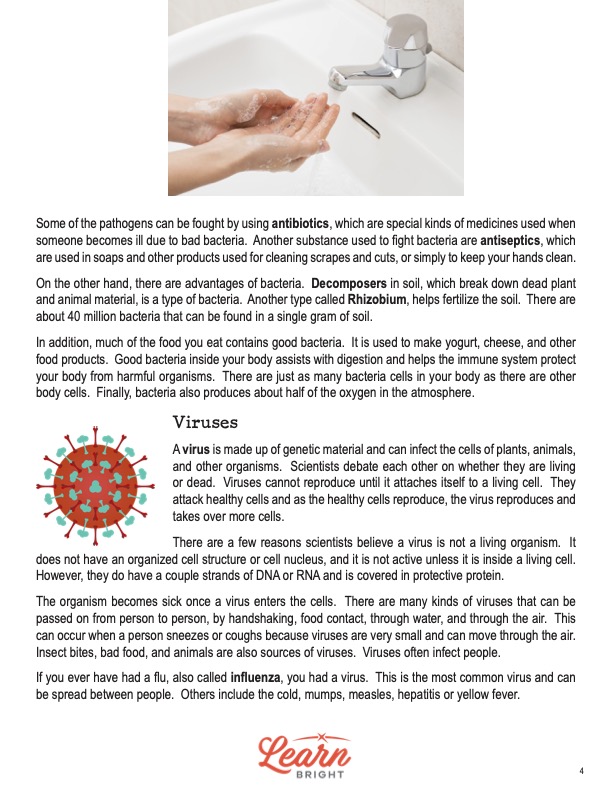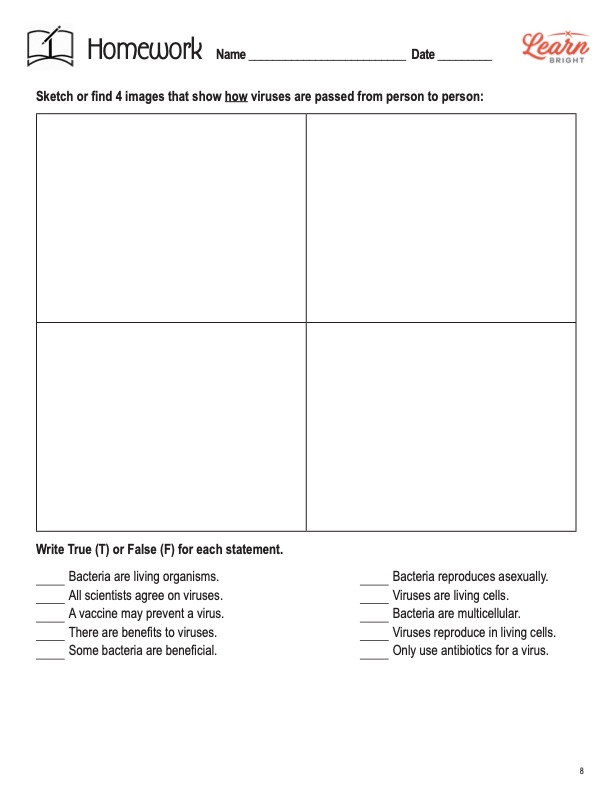Description
What our Bacteria and Viruses lesson plan includes
Lesson Objectives and Overview: Bacteria and Viruses teaches students to define these terms and learn to tell the differences between them. Students will discover the traits of both and will be able to compare and contrast the two. They will also learn how bacteria can be good or bad and that viruses may not be living organisms at all. This lesson is for students in 5th grade and 6th grade.
Classroom Procedure
Every lesson plan provides you with a classroom procedure page that outlines a step-by-step guide to follow. You do not have to follow the guide exactly. The guide helps you organize the lesson and details when to hand out worksheets. It also lists information in the yellow box that you might find useful. You will find the lesson objectives, state standards, and number of class sessions the lesson should take to complete in this area. In addition, it describes the supplies you will need as well as what and how you need to prepare beforehand. The supplies you will need for this lesson are construction paper, scissors, glue, magazines, and colored pencils or markers or other coloring utensils. You will also need to ensure students have internet access.
Options for Lesson
There are several suggestions in the “Options for Lesson” section of the classroom procedure page that you can incorporate into the lesson. One suggestion is to have students vote on each other’s posters in the categories of most colorful, best images, and more. You could plan a school- or grade-wide “Prevent Illness” week and display the posters around the classrooms or hallways. You could also invite the school nurse or another medical professional to speak to the class about this subject. Another option is to obtain microscopes that students can use to view live bacteria. One final suggestion is to assign students a specific disease or illness to research and present to the class.
Teacher Notes
The paragraph on this page provides extra guidance or information about the lesson plan. It mentions the importance of stressing that bacteria does not need to be a negative topic. It also suggests teaching this lesson in conjunction with a lesson about Asexual Reproduction. Use the blank lines to write down any other thoughts or ideas you have about the lesson as you prepare.
BACTERIA AND VIRUSES LESSON PLAN CONTENT PAGES
Organisms
The Bacteria and Viruses lesson plan contains three pages of content. The first page introduces students to the concepts of the lesson by describing what an organism is. An organism is a living thing that can function independently (on its own). Examples include anything from a bug or a fish to a horse, a whale, a human, or an elephant. They come in all shapes and sizes. Nearly all organisms need other organisms to survive.
Some organisms are so tiny that they are invisible without the help of a powerful microscope. Many of these live inside the human body. They are everywhere in the world. These are called bacteria. Bacteria are alive and can survive very harsh conditions. Some are not very good and can cause sicknesses. Another tiny organism, called a virus, also causes sicknesses. Scientists debate whether or not a virus is alive. People often refer to both of these tiny things as germs.
Bacteria
While most organisms are a collection of many different cells, bacteria have only a single cell. Furthermore, they have no nucleus, but most of them have a cell wall like plant cells. The shapes of bacteria vary from rods to spirals to spheres. They move in many different ways as well. Some act like swimmers in water as they use long tails, or flagella, to glide around. Others remain still. And others simply slither or slide. There is no bacteria that is visible without a microscope.
The lesson shows a picture of a type of bacteria and labels the different parts of its cell. Some of the parts are cytoplasm, ribosomes, pili, plasmids, and plasma membranes. Some of these parts exist in animal and plant cells. Others exist only in bacteria cells.
Not all bacteria are bad, but the ones that are bad and that can make people sick are called pathogens. Pathogens can cause food poisoning, leprosy, strep throat, and other sicknesses. One way to fight these pathogens is by using antibiotics, which are special medicines used specifically to fight bacterial infections or illnesses. Antiseptics are another way. Soaps and other cleaning products for cleaning scrapes and cuts contain antiseptics.
Good bacteria, on the other hand, have their advantages. Decomposers are a type of bacteria that break down dead plant and animal material. Another type is the rhizobium, which helps fertilize soil. Students will discover that about 40 million bacteria could exist in a single gram of soil! Some foods also contain bacteria, such as yogurt and cheese. Good bacteria help with digestion or improve the immune system’s ability to protect the body from harmful organisms.
Viruses
Students will next learn about viruses. A virus consists of genetic material that can infect the cells of plants, animals, and other organisms. Scientists disagree on whether or not viruses are alive. They attack healthy cells, and when the healthy cells reproduce, the virus reproduces with it and thus spreads.
There are a few reasons certain scientists don’t believe viruses are living organisms. One is that, like bacteria, they have no nucleus, but they also have no organized cell structure at all. And, of course, they are inactive unless they attach to living cells. What they do have are a few strands of DNA or RNA that are covered in protective protein.
When a virus infects an organism, it causes that organism to become sick. Viruses can pass from one organism to another through handshaking, food contact, water, and air. The common flu (influenza) is the most common virus and can easily spread between people. Other viruses include colds, mumps, and yellow fever. The lesson explains a few ways to help avoid getting sick, including keeping your hands clean, cooking food properly, and getting plenty of sleep. Vaccines are another way to help prevent contracting a sickness due to a particular virus.
BACTERIA AND VIRUSES LESSON PLAN WORKSHEETS
The Bacteria and Viruses lesson plan includes three worksheets: an activity worksheet, a practice worksheet, and a homework assignment. The worksheets will help solidify students’ grasp of the material they learned throughout the lesson and gauge where they might need extra help. You can use the guidelines on the classroom procedure page to determine when to hand out each worksheet.
TWO POSTERS ACTIVITY WORKSHEET
Students will work with a partner for the activity. (You can also have them work alone or in small groups if you prefer.) Students will use construction paper or poster board to create two posters. One will relate to bacteria and the other to viruses. Poster one should encourage people to fight illnesses that bacteria cause and display some positive facts about good bacteria. Poster two should show how people can prevent viruses and their spread. The posters should be colorful and creative.
BACTERIA AND VIRUSES PRACTICE WORKSHEET
There are two sections for the practice worksheet. The first section requires students to answer 10 questions about bacteria using the words in the word bank. They will use each term only once. The second section requires students to answer 10 more questions about viruses.
FOUR IMAGES HOMEWORK ASSIGNMENT
For the homework assignment, students will find or sketch four images that show how a virus passes from person to person. A second section requires them to mark whether 10 statements are true (T) or false (F).
Worksheet Answer Keys
The final pages of the document are answer keys for the worksheets. The answer key for the activity worksheet describes that students’ responses may vary. It does, however, provide some information that students may include on their posters. For the practice worksheet and second part of the homework assignment, the answers are in red. There may be some variation on questions 13 and 20 of the practice worksheet. The first part of the homework assignment requires students to draw pictures, so these may also vary a bit. The answer key provides some examples of what students might draw. If you choose to administer the lesson pages to your students via PDF, you will need to save a new file that omits these pages. Otherwise, you can simply print out the applicable pages and keep these as reference for yourself when grading assignments.











